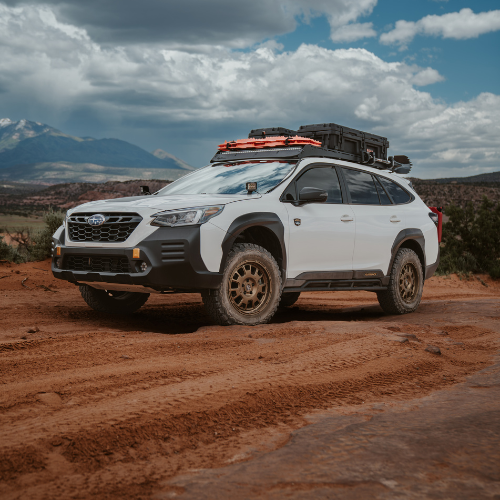What is an auxiliary light controller?
Simply put, an auxiliary light controller is a device that, when connected properly to your vehicle, can control all off-road lights, compressors, refrigerators, and a whole lot more.
How to pick an Auxiliary Light Controller?
Now this question is more of a matter of opinion, but since we have some experience on the subject, I will do my best to remain neutral but provide our experience to help guide your decision-making or at least help take some of the questions out of the equation. Let us start with the different options and go over how we came to our decision. The list below is what we consider when purchasing an auxiliary light controller or pretty much any part for a vehicle. I will also give you our top pick for auxiliary light controllers based on user experience.
- Ease of install
- Cost
- Reviews
- Durability
Ease Of install
Starting with number one, ease of installation on any overlanding component is important, but it shouldn't be the only thing considered when making a purchase. Often times the easier it is to install, the less of a beating it can take. We generally take the ease of installation with a grain of salt because a little more upfront work can make for a better long-lasting solution.
Cost
Cost can be a huge limiting factor in what auxiliary light controller you choose for your off-road or overland rig, but sometimes the cheaper option is actually better than, the more expensive one. One thing to consider with this is how many components you plan to have connected to the device and how much power they draw. I don't want to bore you with electrical specifications, but you want to ensure you have enough amps to power the various items you plan to power through the auxiliary switch. That can be done by finding how many amps the controller can handle and then simply adding up how many amps your components need to work.
Reviews
Reviews can be another great way to decide what light controller to go with. Almost every website these days offers user reviews and most of the time those are true and accurate. I would do some light reading in the review section of these products to ensure you're buying a product that other people use and trust.
Durability
Durability is also another huge factor. Controlling your lights and other components inside your vehicle sounds like a simple task and something that may not end up being extremely important, but if you come off a trail with low tires and your compressor won't turn on, then you have a problem; we don't like problems. The product reviews section of a website will often give you answers to the durability question as well. Don't be scared to phone a friend or reach out to someone on Instagram to get your desired answer. Most people are more than willing to help!
Our Choice For Auxiliary Light Controller
You probably guessed it already, but our top pick for an auxiliary light controller is the 6 gang Auxbeam light controller. We have used this very controller in many of our vehicle builds and it has yet to fail on us a single time. This price of this controller makes it cheaper than most, but that price doesn't come with any cut corners. The install is not hard, although it does require a small amount of wiring that can be done by anyone with a willingness to learn and a good attitude.
How Does the Auxbeam Auxiliary Controller work?
The Auxbeam light controller is made up of two important pieces, one being the "brains' of the systems that house all your fuses as well as the wires that connect to your positive battery terminal and a grounding location and the other being your switch panel that has buttons which go inside the vehicle. The fuse box, which we will refer to as the brains, is what goes under the hood and connects to the battery to provide power to your entire auxiliary light setup. The grounding location can be the negative terminal on your battery or a ground post on the frame of your vehicle. Whichever you prefer will do the job. There is another smaller positive wire that is generally connected to an auxiliary fuse inside your fuse panel which is done through a fuse tap to provide power to the control switch. If all that sounds too complicated, below is a video to help you better understand the entire unit and how it works in a visual fashion.
Bluetooth vs. Hardwired Auxiliary Light Controller
This question is the question we get asked more than any other when it comes to picking the best auxiliary light controller for an overland rig. Again, because we have experience in the matter, we will give our take on which is the better choice and why.
Bluetooth Auxiliary Light Controller
These units have a lot of expectations put on them, and because they're by far an easier install, they oftentimes get picked. We made this choice twice on vehicles we owned. The installation was easy, and the system seemed to work fine, but ultimately it failed twice. The reason we do not recommend these units at all is simply because of how the device is set up to work. Relying on a signal from the controller to the "brains' of the unit that lives under the hood may seem like a reasonable thing to do, but just like your cell phone and other devices you may use for Bluetooth, the signal drops from time to time, and a reset of the entire unit may be required regularly to keep the Bluetooth controller working as it's intended to. For this reason, we recommend you do not take the chance to use a Bluetooth device to control your off-road lights or any other component that you may need at a moment's notice. We learned this lesson the hard way, twice, and you don't have to make the same mistakes we did.
Hardwired Auxiliary Light Controller
These auxiliary controllers definitely make the installation more difficult, but having a hard-wired connection from the battery to the switch panel makes for a constant connection that unless otherwise tampered with or installed improperly, will last as long as your vehicle. Yes, they're more difficult to install, but as with most things, the more work you do on the front end, the less you will have to do later. We recommend you take the time, in the beginning, to ensure you don't have an issue later down the line. Obviously, this is our opinion, but having had both auxiliary light controllers on our vehicles we believe we have a bit of expertise on the topic.








